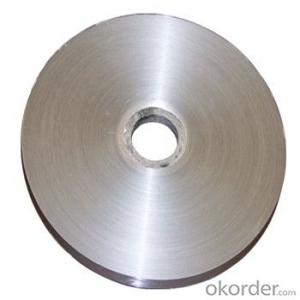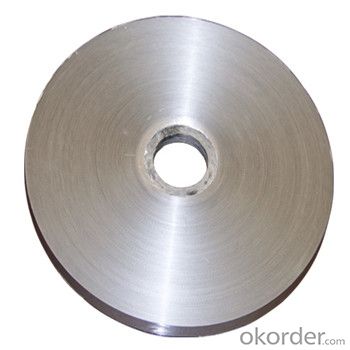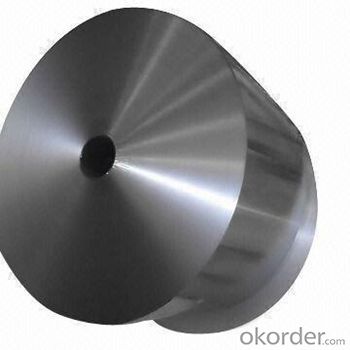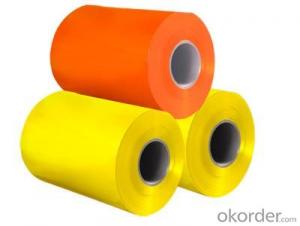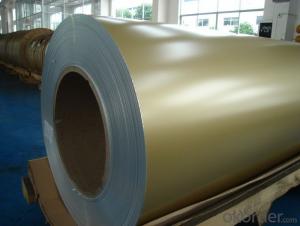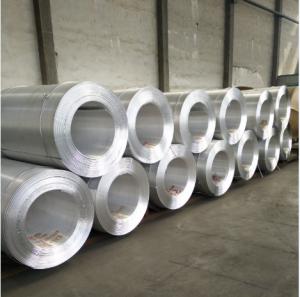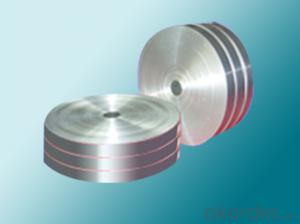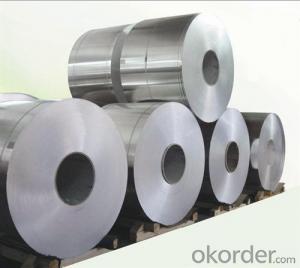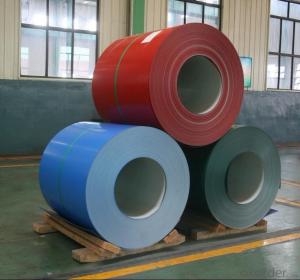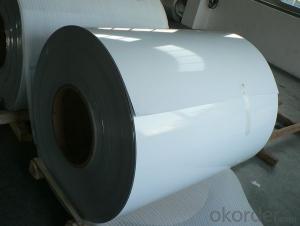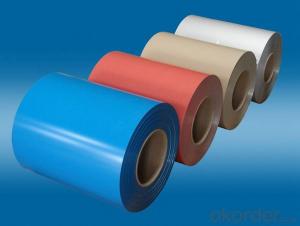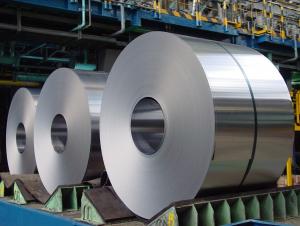Painting Aluminum Coil Stock for Cable & Wire Production
- Loading Port:
- China main port
- Payment Terms:
- TT OR LC
- Min Order Qty:
- 3 m.t
- Supply Capability:
- 10000 m.t/month
OKorder Service Pledge
OKorder Financial Service
You Might Also Like
Specification
1. Description of Plain Aluminium Foil for Cable & Wire Production
Aluminium foil polyester film lamianted (ALU PET) from aluminum foil provides waterproof and thermal insulation. Polyetser film acts as protection aluminum foil and high strength tensile.
| Constructure | Total Thickness | Weight | Yield |
| (g/m2) | (m2/kg) | ||
| AL7 PET12 | 22 mic | 39 | 25.6 |
| AL9 PET12 | 24 mic | 44 | 22.7 |
| A10 PET12 | 25 mic | 47 | 21.3 |
| AL7 PET12 AL7 | 32 mic | 63 | 15.9 |
| AL9 PET12 AL9 | 36 mic | 74 | 13.5 |
| AL10 PET12 AL10 | 38 mic | 79 | 12.7 |
| AL7 PET12 HDPE15 MPET12 | 67 mic | 104 | 9.6 |
| AL9 PET12 HDPE15 MPET12 | 69 mic | 106 | 9.4 |
| MPET12 HDPE15 MPET12 | 48 mic | 65 | 15.4 |
2. Advantages of Plain Aluminium Foil for Cable & Wire Production
1.High strength of polyester film, waterproof thermal insualtion of aluminum foil
2.New and good quality basic materials
3.RoHS and SGS standard
Aluminium foil material ALU / PET tape is used for Ventilation Industry for flexible duct pipe production,Electronic, HVAC system, Estate Construction and so on.
3. Feature of Plain Aluminium Foil for Cable & Wire Production
*Such coil is specially designed to replace aluminum ingot, due to the high export tax of aluminum ingot, the coil has better price than ingot.
*This type of coil can fit customer's remelting furnace just like ingot, no need to make any change to the production line that was previously used for ingot. The standard coil size and weight is very suitable for the feed gate of furnace.
*This type of coil causes less material wastage than ingot when remelted.
*Our coil is made directly from ore, no need to go though the ingot making process, quality is much better than other suppliers who use ingot scrap to make coil.
Be free from Oil Stain, Dent, Inclusion, Scratches, Stain, Oxide Dicoloration, Breaks, Corrosion, Roll Marks, Dirt Streaks and other defect which will interfere with use
4. Certificate:
SGS and ROHS(if client request, paid by client), MTC(plant provided), Certificate of Origin(FORM A, FORM E, CO), Bureau Veritas and SGS (if client request, paid by client), CIQS certificate
5. Image of Plain Aluminium Foil for Cable & Wire Production
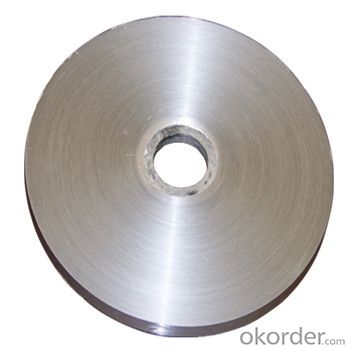
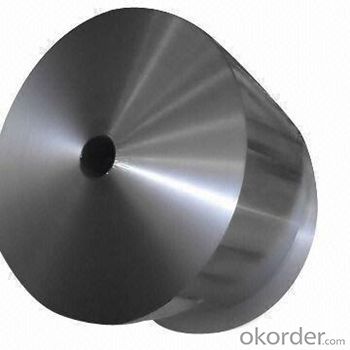
6. Package and shipping of Plain Aluminium Foil for Cable & Wire Production
eye to sky
eye to wall
with wooden pallet (wooden case also available)
7. FAQ
1) What is the delivery time?
Dpends on actual order, around 20 days
2) What is the QC system:
We have QC staff of 20 persons and advanced equipment, each production is with MTC traced from Aluminum ingot lot.
3) What market do you mainly sell to?
Australia, America, Asia, Middle East, Western Europe, Africa etc
- Q: What are the potential applications of embossed aluminum coils?
- Some potential applications of embossed aluminum coils include roofing and cladding for buildings, decorative elements for interior design, automotive trim and accents, signage and advertising displays, and packaging materials for food and beverage industries. The embossed pattern on the surface of the aluminum coils provides not only aesthetic appeal but also increased durability, corrosion resistance, and anti-slip properties in certain applications.
- Q: How do aluminum coils contribute to reduced material waste?
- Aluminum coils contribute to reduced material waste in several ways. Firstly, aluminum is a highly recyclable material, meaning that it can be melted down and reused multiple times without losing its properties. This recyclability factor alone contributes to reducing material waste as it prevents the need for new aluminum extraction and production. Additionally, aluminum coils are often used in industries where precision and efficiency are crucial, such as in the manufacturing of automobiles, HVAC systems, and electrical equipment. These coils can be easily customized to meet specific requirements, minimizing the need for excess material and reducing waste. Furthermore, aluminum coils offer high strength-to-weight ratio, meaning that they can be manufactured using less material while still maintaining the desired strength and durability. This lightweight characteristic contributes to reduced material waste as it allows for more efficient transportation and installation processes, resulting in lower fuel consumption and less environmental impact. Moreover, aluminum coils can be designed for longer lifespan and improved corrosion resistance. This durability factor helps to minimize the frequency of replacement, reducing material waste over time. Additionally, the long lifespan of aluminum coils makes them an attractive choice for sustainable construction practices, further contributing to reduced waste in the long run. Overall, the use of aluminum coils in various industries not only promotes recycling and reusability but also enables efficient customization, lightweight construction, enhanced durability, and extended lifespan. These factors collectively contribute to reducing material waste and making aluminum coils an environmentally-friendly choice.
- Q: Are aluminum coils suitable for electrical transformers?
- Electrical transformers can indeed utilize aluminum coils. Aluminum, being a lightweight and cost-effective material, presents numerous advantages when it comes to transformer construction. Its electrical conductivity is outstanding, comparable to that of copper, which ensures efficient power transfer. Moreover, aluminum coils exhibit lower resistance than their copper counterparts, thereby reducing power losses and enhancing energy efficiency. The utilization of aluminum coils also aids in weight reduction, resulting in easier handling and transportation. Nonetheless, due to their marginally lower conductivity, aluminum coils necessitate larger cross-sections compared to copper coils. Consequently, transformers employing aluminum coils may exhibit a slightly larger size. Nevertheless, overall, aluminum coils serve as a viable and extensively employed substitute for copper coils in electrical transformers, offering cost savings, high conductivity, and improved energy efficiency.
- Q: at what state is aluminum at room temperature?what are aluminums physical properties?what is aluminum obtained from?
- 1. Solid, liquid, or gas... I bet you can guess. 2. There's a mess of them in the right side info box of the wikipedia article:
- Q: Can aluminum coils be used in architectural applications?
- Aluminum coils, indeed, find application in architectural projects. The construction industry frequently employs aluminum due to its adaptability, endurance, and ease of manipulation. Architects often make use of aluminum coils for roofing, cladding, and facades, thanks to their malleability in creating diverse forms and proportions. Furthermore, these coils can be coated with various finishes to improve their visual appeal and safeguard against weathering and discoloration. Ultimately, given their blend of utility, attractiveness, and durability, aluminum coils have become a favored option for architectural purposes.
- Q: This question asks for the method to calculate the weight of an aluminum coil given its size.
- <p>To calculate the weight of an aluminum coil, you need to know its dimensions and the density of aluminum. The formula to calculate the weight is: Weight = Volume 脳 Density. First, determine the volume of the coil by multiplying its length (L), width (W), and thickness (T): Volume = L 脳 W 脳 T. The density of aluminum is approximately 2.7 grams per cubic centimeter (g/cm鲁). Convert the volume to cubic centimeters if it's not already. Then, multiply the volume by the density to get the weight in grams. To convert grams to kilograms, divide by 1000. This will give you the weight of the aluminum coil.</p>
- Q: Can aluminum coils be recycled multiple times?
- Aluminum coils possess the remarkable ability to be recycled numerous times. This is due to the fact that aluminum is an exceptionally recyclable substance, and its quality remains unaltered throughout the recycling process. As a result, aluminum coils can be melted and reshaped into fresh coils on multiple occasions, without experiencing any deterioration in their performance or characteristics. The act of recycling aluminum not only aids in the preservation of natural resources, but it also conserves a significant amount of energy compared to the production of new aluminum using raw materials. Consequently, opting for aluminum coils is a sustainable and eco-friendly decision, as they can be recycled multiple times.
- Q: Can aluminum coils be used for automotive heat shields?
- Yes, aluminum coils can be used for automotive heat shields. Aluminum is a commonly used material for heat shields due to its excellent thermal conductivity and high melting point. It is lightweight and has good corrosion resistance, making it ideal for automotive applications. Aluminum coils can be easily formed into the desired shape and provide effective heat insulation, protecting sensitive components from excessive heat generated by the engine or exhaust system. Additionally, aluminum is cost-effective and readily available, making it a popular choice for automotive heat shields.
- Q: A piece of aluminum foil 0.550 mm thick and 1.00 cm square is allowed to react with bromine to form aluminum bromide?a) How many mole of aluminum were used? ( The density of aluminum is 2.699 g/cm3.)I keep getting the same answer which I know is wrong. I used a formula to get the volume and then the mass to get the moles, but maybe this is wrong. Could someone explain the process. I got 4.32 x 10-1 mol Al, but the answer is 5.50 x 10-3 mol Al.
- 0.550mm = 0.055cm 0.055 x 1 x 1 = 0.055cc x 2.699g/cc = 0.1484g Al. Mol.mass = 27 g/mole 0.1484 ÷ 27 = 0.0055 moles. (5.5 x10-?)
- Q: What are the different coil winding methods for aluminum coils?
- Aluminum coils can be wound using various methods, each offering unique advantages and suitability for specific applications. Let's explore these methods: 1. Layer winding: By winding the aluminum wire in a single layer around the coil mandrel, this method proves useful in low voltage scenarios. It excels at thermal conductivity and heat dissipation. 2. Random winding: Without adhering to any specific pattern, the aluminum wire is randomly wound around the coil mandrel. This method is preferred for high voltage applications as it minimizes the risk of corona discharge and enhances insulation. 3. Concentric winding: As implied by its name, concentric winding involves winding the aluminum wire in concentric circles around the coil mandrel. It is ideal for space-restricted applications, enabling a high number of turns in a compact coil. 4. Interleaved winding: This method entails winding multiple layers of aluminum wire in an interleaved pattern. It reduces the overall size of the coil while maintaining a high number of turns and increasing inductance. 5. Helical winding: Here, the aluminum wire is wound in a helix pattern, either with a constant or varying pitch. Helical winding is commonly employed in applications requiring high inductance, such as inductors and transformers. 6. Sectional winding: In this method, the coil is divided into multiple sections, with each section being wound separately. It is commonly used in large-scale applications, making coil handling and installation easier. Each of these coil winding methods possesses its own strengths and considerations. The choice of method depends on specific application requirements, space limitations, and desired electrical characteristics.
Send your message to us
Painting Aluminum Coil Stock for Cable & Wire Production
- Loading Port:
- China main port
- Payment Terms:
- TT OR LC
- Min Order Qty:
- 3 m.t
- Supply Capability:
- 10000 m.t/month
OKorder Service Pledge
OKorder Financial Service
Similar products
Hot products
Hot Searches
Related keywords
